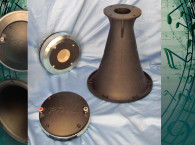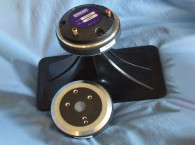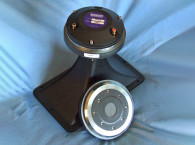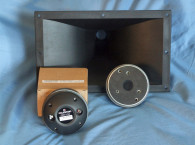
Features for the D4400Ph include a one-piece phenolic resin diaphragm and surround, with a throat diameter of 50 mm (2”). The phenolic resin diaphragm is coupled to a 101.6 mm (4”) diameter voice coil wound with CCAW wire on a Kapton former. Other features include a cast-aluminum body with the PRV Audio logo, a field replaceable diaphragm; 200 WRMS rated power handling (400 W with program material), a minimum crossover of 700 Hz (using a second-order network), a ferrite ring magnet motor, and color-coded push terminals. I used the PRV WGP22-50 horn to characterize this transducer, which was the same one I used with the D4400Ti-ND.
I used the LinearX LMS analyzer to produce the 200-point stepped sine wave impedance plot shown in Figure 1. The solid black curve represents the D4400Ph mounted on the horn and the dashed blue curve represents the compression driver without the horn. With a 6.02 Ω DCR, the minimum impedance of the D4400Ph/WGP22-50 was 6.93 Ω at 376 Hz.





For the next group of tests, I mounted the D4400Ph/WGP22-50 without an enclosure in free air and measured the horizontal on and off axis (no vertical plane measurements were made since the WGP22-50 is a round 60° × 60° device). I used a 100-point gated sine wave sweep at 2.83 V/1 m. Figure 2 displays the on-axis results for the D4400Ph/WGP22-50. The response is approximately ±2 dB from the minimum recommended crossover frequency of 2.2 to 10 kHz, with a declining response above 14 kHz where the low-pass roll-off begins.
Figure 3 shows the on- and off-axis horizontal plane response from 0° to 60°. Figure 4 shows the off-axis normalized to the on-axis response for the horizontal axis measurement. The Audiomatica CLIO Pocket analyzer generated the 180° polar plot (with 10° increments) shown in Figure 5. The last SPL measurement is illustrated in Figure 6 and shows the two-sample SPL comparison of the D4400Ph/WGP22-50, indicating both samples to be reasonably well matched in the relevant operating range, with some minor variances.
I employed the Listen AmpConnect ISC analyzer and 0.25” SCM microphone, using SoundCheck 14 software to measure distortion and generate time-frequency plots. For the distortion measurement, I mounted the D4400Ph/WGP22-50 combination in free air sans baffle and used a pink noise stimulus to set the SPL to 104 dB at 1 m (1.05 V). I measured the distortion with the Listen microphone placed 10 cm from the mouth of the horn. This produced the distortion curves shown in Figure 7.


I then used SoundCheck to get a 2.83 V/1 m impulse response and imported the data into Listen’s SoundMap Time/Frequency software. Figure 8 shows the resulting CSD waterfall plot. Figure 9 shows the STFT plot. The PRV D4400Ph exhibits the same build quality as the PRV D4400Ti-Nd, and is a good high power handling and high sensitivity midrange performer. For more information, visit www.prvaudio.com. VC


This article was originally published in Voice Coil, May 2017.







